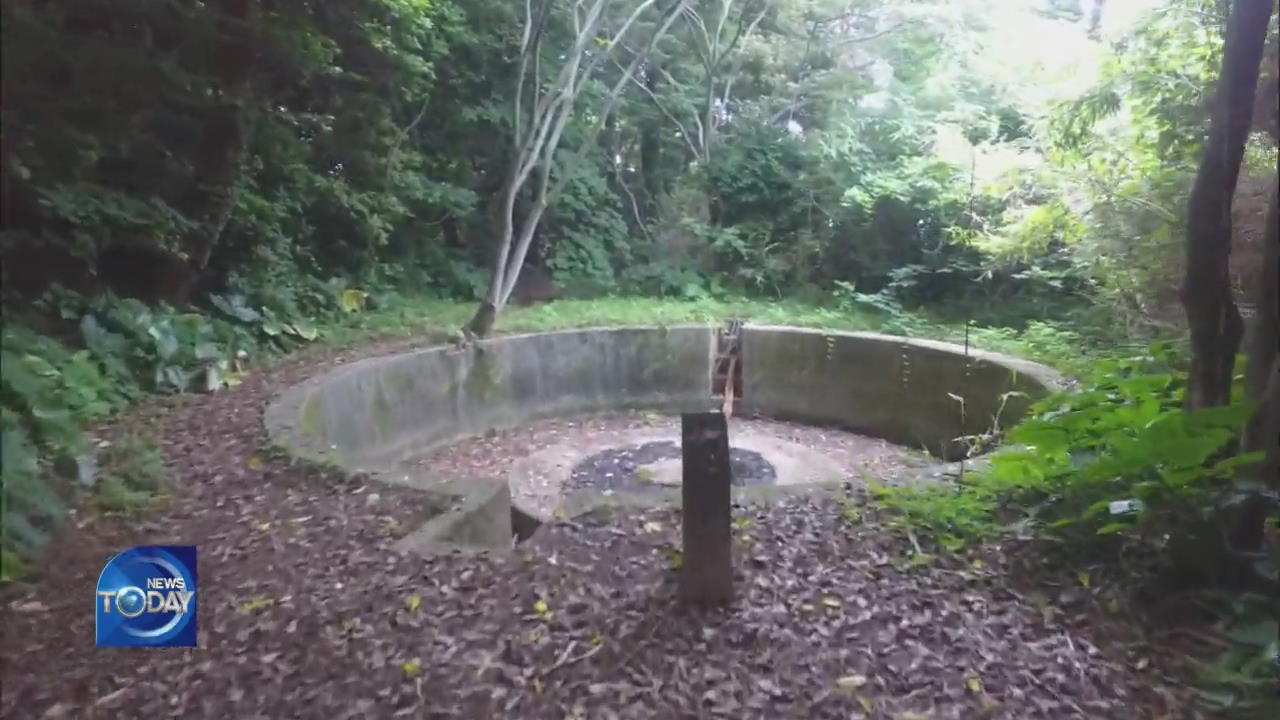NATIONAL PARKS WITH HISTORIC TRACES
입력 2019.08.14 (15:08)
수정 2019.08.14 (16:45)
읽어주기 기능은 크롬기반의
브라우저에서만 사용하실 수 있습니다.
[Anchor Lead]
Odaesan and Hallyeohaesang National Parks in Korea, known for their breathtaking scenery, hold numerous traces of resource looting, and Japanese military facilities from the colonial era. The Korea National Park Service has introduced these historic sites ahead of Independence Day.
[Pkg]
Odaesan National Park is known for its dense forest of fir trees. A walk along a cool valley into the woods leads to a pile of rocks covered in moss. The site had been used as a home to slash-and-burn farmers during the Japanese colonial period. They were exploited by the Japanese, who looted Korea's timber resources en masse.
[Soundbite] KIM JAE-BU(TOUR GUIDE, KOREA NATIONAL PARK SERVICE) : "Some 360 households used to live here. Traces of some 50 houses still remain."
A cart path used to transport logs remains here. Locals still vividly remember the heartbreaking stories of what happened to their fathers and grandfathers.
[Soundbite] KIM UNG-KI(LOCAL RESIDENT) : "I don't think the Japanese paid the farmers properly. We can only imagine how hard life was for them at the time."
Jisimdo islet in Hallyeohaesang National Park used to be a Japanese Navy fortress during the colonial era. Its four gun emplacements have been preserved in their original form. A tunnel for storing ammunition and a house belonging to Japanese soldiers have also been preserved intact.
[Soundbite] YOON MAN-HEON(GYEONGGI-DO PROV. RESIDENT) : "I used to pass by such places when I hiked in the mountains. But today I had an opportunity to take a close look at the traces of 36 years of Japanese colonization."
The Korea National Park Service has launched tours of historic sites on Odaesan Mountain and Jisimdo islet ahead of Independence Day.
Odaesan and Hallyeohaesang National Parks in Korea, known for their breathtaking scenery, hold numerous traces of resource looting, and Japanese military facilities from the colonial era. The Korea National Park Service has introduced these historic sites ahead of Independence Day.
[Pkg]
Odaesan National Park is known for its dense forest of fir trees. A walk along a cool valley into the woods leads to a pile of rocks covered in moss. The site had been used as a home to slash-and-burn farmers during the Japanese colonial period. They were exploited by the Japanese, who looted Korea's timber resources en masse.
[Soundbite] KIM JAE-BU(TOUR GUIDE, KOREA NATIONAL PARK SERVICE) : "Some 360 households used to live here. Traces of some 50 houses still remain."
A cart path used to transport logs remains here. Locals still vividly remember the heartbreaking stories of what happened to their fathers and grandfathers.
[Soundbite] KIM UNG-KI(LOCAL RESIDENT) : "I don't think the Japanese paid the farmers properly. We can only imagine how hard life was for them at the time."
Jisimdo islet in Hallyeohaesang National Park used to be a Japanese Navy fortress during the colonial era. Its four gun emplacements have been preserved in their original form. A tunnel for storing ammunition and a house belonging to Japanese soldiers have also been preserved intact.
[Soundbite] YOON MAN-HEON(GYEONGGI-DO PROV. RESIDENT) : "I used to pass by such places when I hiked in the mountains. But today I had an opportunity to take a close look at the traces of 36 years of Japanese colonization."
The Korea National Park Service has launched tours of historic sites on Odaesan Mountain and Jisimdo islet ahead of Independence Day.
■ 제보하기
▷ 카카오톡 : 'KBS제보' 검색, 채널 추가
▷ 전화 : 02-781-1234, 4444
▷ 이메일 : kbs1234@kbs.co.kr
▷ 유튜브, 네이버, 카카오에서도 KBS뉴스를 구독해주세요!
- NATIONAL PARKS WITH HISTORIC TRACES
-
- 입력 2019-08-14 15:08:55
- 수정2019-08-14 16:45:37

[Anchor Lead]
Odaesan and Hallyeohaesang National Parks in Korea, known for their breathtaking scenery, hold numerous traces of resource looting, and Japanese military facilities from the colonial era. The Korea National Park Service has introduced these historic sites ahead of Independence Day.
[Pkg]
Odaesan National Park is known for its dense forest of fir trees. A walk along a cool valley into the woods leads to a pile of rocks covered in moss. The site had been used as a home to slash-and-burn farmers during the Japanese colonial period. They were exploited by the Japanese, who looted Korea's timber resources en masse.
[Soundbite] KIM JAE-BU(TOUR GUIDE, KOREA NATIONAL PARK SERVICE) : "Some 360 households used to live here. Traces of some 50 houses still remain."
A cart path used to transport logs remains here. Locals still vividly remember the heartbreaking stories of what happened to their fathers and grandfathers.
[Soundbite] KIM UNG-KI(LOCAL RESIDENT) : "I don't think the Japanese paid the farmers properly. We can only imagine how hard life was for them at the time."
Jisimdo islet in Hallyeohaesang National Park used to be a Japanese Navy fortress during the colonial era. Its four gun emplacements have been preserved in their original form. A tunnel for storing ammunition and a house belonging to Japanese soldiers have also been preserved intact.
[Soundbite] YOON MAN-HEON(GYEONGGI-DO PROV. RESIDENT) : "I used to pass by such places when I hiked in the mountains. But today I had an opportunity to take a close look at the traces of 36 years of Japanese colonization."
The Korea National Park Service has launched tours of historic sites on Odaesan Mountain and Jisimdo islet ahead of Independence Day.
Odaesan and Hallyeohaesang National Parks in Korea, known for their breathtaking scenery, hold numerous traces of resource looting, and Japanese military facilities from the colonial era. The Korea National Park Service has introduced these historic sites ahead of Independence Day.
[Pkg]
Odaesan National Park is known for its dense forest of fir trees. A walk along a cool valley into the woods leads to a pile of rocks covered in moss. The site had been used as a home to slash-and-burn farmers during the Japanese colonial period. They were exploited by the Japanese, who looted Korea's timber resources en masse.
[Soundbite] KIM JAE-BU(TOUR GUIDE, KOREA NATIONAL PARK SERVICE) : "Some 360 households used to live here. Traces of some 50 houses still remain."
A cart path used to transport logs remains here. Locals still vividly remember the heartbreaking stories of what happened to their fathers and grandfathers.
[Soundbite] KIM UNG-KI(LOCAL RESIDENT) : "I don't think the Japanese paid the farmers properly. We can only imagine how hard life was for them at the time."
Jisimdo islet in Hallyeohaesang National Park used to be a Japanese Navy fortress during the colonial era. Its four gun emplacements have been preserved in their original form. A tunnel for storing ammunition and a house belonging to Japanese soldiers have also been preserved intact.
[Soundbite] YOON MAN-HEON(GYEONGGI-DO PROV. RESIDENT) : "I used to pass by such places when I hiked in the mountains. But today I had an opportunity to take a close look at the traces of 36 years of Japanese colonization."
The Korea National Park Service has launched tours of historic sites on Odaesan Mountain and Jisimdo islet ahead of Independence Day.
이 기사가 좋으셨다면
-
좋아요
0
-
응원해요
0
-
후속 원해요
0

















이 기사에 대한 의견을 남겨주세요.